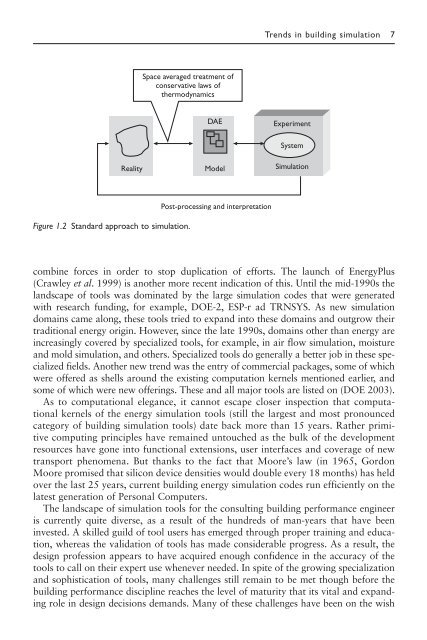Advanced Building Simulation
Advanced Building Simulation
Advanced Building Simulation
Create successful ePaper yourself
Turn your PDF publications into a flip-book with our unique Google optimized e-Paper software.
Reality<br />
Space averaged treatment of<br />
conservative laws of<br />
thermodynamics<br />
Figure 1.2 Standard approach to simulation.<br />
DAE<br />
Model<br />
Post-processing and interpretation<br />
Trends in building simulation 7<br />
Experiment<br />
System<br />
<strong>Simulation</strong><br />
combine forces in order to stop duplication of efforts. The launch of EnergyPlus<br />
(Crawley et al. 1999) is another more recent indication of this. Until the mid-1990s the<br />
landscape of tools was dominated by the large simulation codes that were generated<br />
with research funding, for example, DOE-2, ESP-r ad TRNSYS. As new simulation<br />
domains came along, these tools tried to expand into these domains and outgrow their<br />
traditional energy origin. However, since the late 1990s, domains other than energy are<br />
increasingly covered by specialized tools, for example, in air flow simulation, moisture<br />
and mold simulation, and others. Specialized tools do generally a better job in these specialized<br />
fields. Another new trend was the entry of commercial packages, some of which<br />
were offered as shells around the existing computation kernels mentioned earlier, and<br />
some of which were new offerings. These and all major tools are listed on (DOE 2003).<br />
As to computational elegance, it cannot escape closer inspection that computational<br />
kernels of the energy simulation tools (still the largest and most pronounced<br />
category of building simulation tools) date back more than 15 years. Rather primitive<br />
computing principles have remained untouched as the bulk of the development<br />
resources have gone into functional extensions, user interfaces and coverage of new<br />
transport phenomena. But thanks to the fact that Moore’s law (in 1965, Gordon<br />
Moore promised that silicon device densities would double every 18 months) has held<br />
over the last 25 years, current building energy simulation codes run efficiently on the<br />
latest generation of Personal Computers.<br />
The landscape of simulation tools for the consulting building performance engineer<br />
is currently quite diverse, as a result of the hundreds of man-years that have been<br />
invested. A skilled guild of tool users has emerged through proper training and education,<br />
whereas the validation of tools has made considerable progress. As a result, the<br />
design profession appears to have acquired enough confidence in the accuracy of the<br />
tools to call on their expert use whenever needed. In spite of the growing specialization<br />
and sophistication of tools, many challenges still remain to be met though before the<br />
building performance discipline reaches the level of maturity that its vital and expanding<br />
role in design decisions demands. Many of these challenges have been on the wish

















